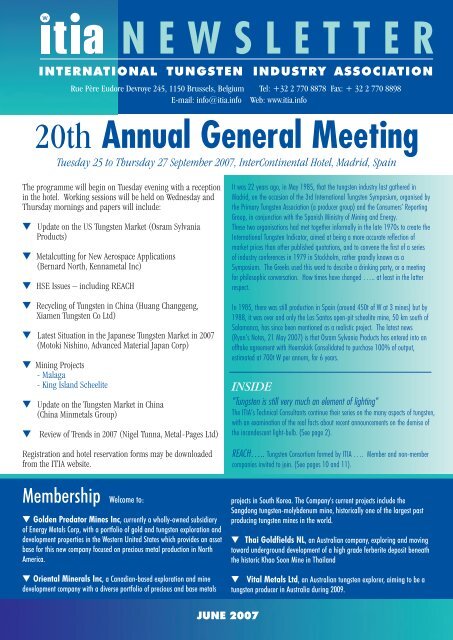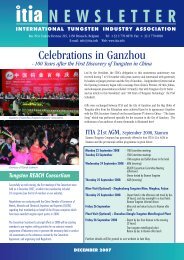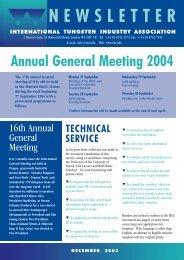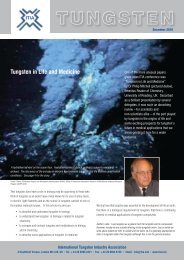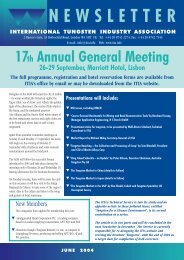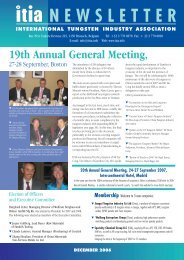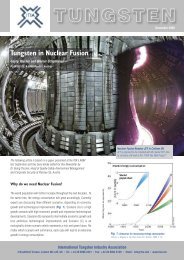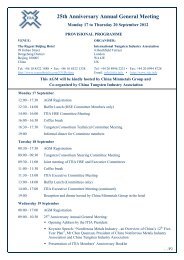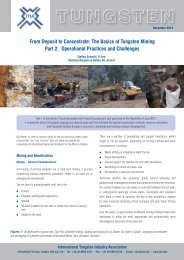June 2007 - International Tungsten Industry Association
June 2007 - International Tungsten Industry Association
June 2007 - International Tungsten Industry Association
You also want an ePaper? Increase the reach of your titles
YUMPU automatically turns print PDFs into web optimized ePapers that Google loves.
w<br />
NEWSLETTER<br />
INTERNATIONAL TUNGSTEN INDUSTRY ASSOCIATION<br />
Rue Père Eudore Devroye 245, 1150 Brussels, Belgium Tel: +32 2 770 8878 Fax: + 32 2 770 8898<br />
E-mail: info@itia.info Web: www.itia.info<br />
20th Annual General Meeting<br />
Tuesday 25 to Thursday 27 September <strong>2007</strong>, InterContinental Hotel, Madrid, Spain<br />
The programme will begin on Tuesday evening with a reception<br />
in the hotel. Working sessions will be held on Wednesday and<br />
Thursday mornings and papers will include:<br />
▼ Update on the US <strong>Tungsten</strong> Market (Osram Sylvania<br />
Products)<br />
▼ Metalcutting for New Aerospace Applications<br />
(Bernard North, Kennametal Inc)<br />
▼ HSE Issues – including REACH<br />
▼ Recycling of <strong>Tungsten</strong> in China (Huang Changgeng,<br />
Xiamen <strong>Tungsten</strong> Co Ltd)<br />
▼ Latest Situation in the Japanese <strong>Tungsten</strong> Market in <strong>2007</strong><br />
(Motoki Nishino, Advanced Material Japan Corp)<br />
▼ Mining Projects<br />
- Malaga<br />
- King Island Scheelite<br />
▼ Update on the <strong>Tungsten</strong> Market in China<br />
(China Minmetals Group)<br />
▼ Review of Trends in <strong>2007</strong> (Nigel Tunna, Metal-Pages Ltd)<br />
Registration and hotel reservation forms may be downloaded<br />
from the ITIA website.<br />
It was 22 years ago, in May 1985, that the tungsten industry last gathered in<br />
Madrid, on the occasion of the 3rd <strong>International</strong> <strong>Tungsten</strong> Symposium, organised by<br />
the Primary <strong>Tungsten</strong> <strong>Association</strong> (a producer group) and the Consumers’ Reporting<br />
Group, in conjunction with the Spanish Ministry of Mining and Energy.<br />
These two organisations had met together informally in the late 1970s to create the<br />
<strong>International</strong> <strong>Tungsten</strong> Indicator, aimed at being a more accurate reflection of<br />
market prices than other published quotations, and to convene the first of a series<br />
of industry conferences in 1979 in Stockholm, rather grandly known as a<br />
Symposium. The Greeks used this word to describe a drinking party, or a meeting<br />
for philosophic conversation. How times have changed ….. at least in the latter<br />
respect.<br />
In 1985, there was still production in Spain (around 450t of W at 3 mines) but by<br />
1988, it was over and only the Los Santos open-pit scheelite mine, 50 km south of<br />
Salamanca, has since been mentioned as a realistic project. The latest news<br />
(Ryan’s Notes, 21 May <strong>2007</strong>) is that Osram Sylvania Products has entered into an<br />
offtake agreement with Heemskirk Consolidated to purchase 100% of output,<br />
estimated at 700t W per annum, for 6 years.<br />
INSIDE<br />
"<strong>Tungsten</strong> is still very much an element of lighting"<br />
The ITIA’s Technical Consultants continue their series on the many aspects of tungsten,<br />
with an examination of the real facts about recent announcements on the demise of<br />
the incandescent light-bulb. (See page 2).<br />
REACH….. <strong>Tungsten</strong> Consortium formed by ITIA …. Member and non-member<br />
companies invited to join. (See pages 10 and 11).<br />
Membership Welcome to:<br />
▼ Golden Predator Mines Inc, currently a wholly-owned subsidiary<br />
of Energy Metals Corp, with a portfolio of gold and tungsten exploration and<br />
development properties in the Western United States which provides an asset<br />
base for this new company focused on precious metal production in North<br />
America.<br />
▼ Oriental Minerals Inc, a Canadian-based exploration and mine<br />
development company with a diverse portfolio of precious and base metals<br />
projects in South Korea. The Company's current projects include the<br />
Sangdong tungsten-molybdenum mine, historically one of the largest past<br />
producing tungsten mines in the world.<br />
▼ Thai Goldfields NL, an Australian company, exploring and moving<br />
toward underground development of a high grade ferberite deposit beneath<br />
the historic Khao Soon Mine in Thailand<br />
▼ Vital Metals Ltd, an Australian tungsten explorer, aiming to be a<br />
tungsten producer in Australia during 2009.<br />
JUNE <strong>2007</strong>
<strong>Tungsten</strong> – Still Very<br />
Much an Element of<br />
Lighting<br />
The light bulb in the focus<br />
of global warming<br />
Wolf-Dieter Schubert , Erik Lassner<br />
Institute of Chemical Technologies and Analytics -<br />
Vienna University of Technology<br />
TUNGSTEN - STILL A SYNONYM<br />
FOR LIGHTING<br />
of a sudden replacement without proper pre-arrangements: supply<br />
difficulties in shops, non-fitting of the lamps into a number of old<br />
sockets; unfamiliar colour rendering (no technical advice);<br />
shortened lifespan through frequent switching; sensitivity of the<br />
electronic devices in areas of high humidity; and, in particular, the<br />
lacking of appropriate (economic) recycling strategies. In addition,<br />
due to the significantly higher initial price of the modern equipment,<br />
the materials had to be subsidized in order to render the respective<br />
cost savings during lamp use to poorer people.<br />
Therefore, a more critical view of the current discussions on lamp<br />
replacement seems wise as the banning of an extremely simple,<br />
mature and versatile product (although of low energy efficiency) by<br />
If you ask the man in the street about the uses of tungsten he will<br />
answer you, most likely (if at all), that it is used for light bulbs in the<br />
form of filaments. This answer appears obvious as the use of<br />
tungsten filaments for lighting has accompanied us during the years,<br />
from youth until old age, and in the long run, the bulb has become a<br />
matter of course, in particular in domestic lighting (Fig.1).<br />
However, it has also been known for a long time that such lamps<br />
have a low energy efficiency (lamp efficacy) as they produce<br />
significantly more heat than light during use and, therefore, energy<br />
saving devices should be used instead of the incandescent bulbs for<br />
cost and energy savings and thus contribute to a more aware<br />
relationship with our environment (Fig.2).<br />
This is nothing new (see Newsletter December 2004) but has<br />
recently gained enormous attention through public discussions on<br />
global warming and CO2 emissions, and quite a few politicians have<br />
discovered the light bulb as a showcase for their responsibility<br />
towards the environment [1-3].<br />
"BAN THE BULB"<br />
Fig. 1: Light bulbs are still a synonym for lighting.<br />
At the dawn of the 20th century they have made the nights to day and<br />
brought a revolution to the light market; they are still produced in numbers<br />
of up to 12 billion lamps per year worldwide;<br />
photo: © Tim McConville/zefa/Corbis<br />
2<br />
In 2005, the Republic of Cuba was the first government to officially<br />
start with the replacement of incandescent bulbs (GLS lamps)<br />
through compact fluorescent lamps (CFL; see below) as a<br />
contribution to the "Year of the Energetic Revolution" (Año de la<br />
Revolutión Enérgética – Operación Ahorro de Energia). However,<br />
this positively driven activity also rapidly showed the disadvantages<br />
discharge lamps or other alternatives needs time to advise<br />
professionals and individual consumers to safeguard their interests<br />
in terms of light quality (colour rendering), real energy savings,<br />
environmental responsibility and individual demands (why not<br />
simply ban gasoline guzzling cars or cheap air travel?).
Fig. 2: Development of lamp efficacies of light sources from 1950 up to 1984 (1m/W).<br />
Already then a series of alternatives were available with lamp efficacies of up to 200 1m/W; first compact fluoescent lamps appeared in the mid eighties.<br />
Today, incandescent bulbs have a maximum efficacy of 15 1m/W at a burning life of 1000 h (compared to 65 1m/W and 12,000 hours for a CFLi)<br />
THE LIGHTING MARKET<br />
Today, more than 15% of the global electric power produced<br />
worldwide serves for light production from several billion lamps [4].<br />
Most of this energy consumed is by discharge lamps (about 70%), the<br />
minor part (about 30%) by incandescent lamps (both light bulbs and<br />
halogen lamps; Fig. 3) [5,6].<br />
80 percent of the light consumption market refers to professional<br />
lighting (industry, commerce, public) and the remaining 20% to<br />
private consumers. In this segment (in particular in domestic<br />
lighting) still the light bulb dominates the market in terms of lot<br />
sizes, besides halogen lamps and, more recently, so called "energy<br />
savers” (CFL – compact fluorescent lamps; see below). The number<br />
of pieces of CFL lamps is still comparatively low, but with steep<br />
annual increases over the past ten years. Their contribution can be<br />
estimated today to be in the order of 1.2 billion lamps produced per<br />
year worldwide. However, this number is still low as compared to the<br />
annual production of filament bulbs, which are about 12 billion<br />
lamps per year, with a still increasing number due to the large<br />
consumer markets in Asia.<br />
This large number makes high<br />
demands on the substitution of<br />
light bulbs by industry, in<br />
particular in considering the<br />
many thousands of speciality<br />
lamps with power ratings from<br />
a few watts up to several<br />
thousand watts which have to<br />
be replaced either by discharge<br />
lamps or by LED devices<br />
(Light Emitting Diodes).<br />
Fig. 3: Energy consumption due to lighting; about 70% of artificial lighting is generated by discharge lamps.<br />
80% of energy consumption is by professional lighting and 20% by the private sector; by courtesy of ELC.<br />
3
the declaration of the Australian environment<br />
minister to ban traditional bulbs by 2010 and to<br />
replace them by energy savers. This would lead<br />
to a reduction of 800,000 tons of CO2 per year in<br />
Australia (as compared to a total of 564 million<br />
tons of CO2 produced annually in 2004; i.e.<br />
0,14% [1]).<br />
EVOLUTION NOT REVOLUTION<br />
Over the last three decades, incandescent lamps have been gradually<br />
replaced by more energy efficient discharge lamps. The switch to<br />
modern lighting has always been for the lamp industry an evolution<br />
and not a revolution [7]. Due to the specific pattern of the lighting<br />
market worldwide the European Lamp Companies Federation (ELC)<br />
has at first put priorities on street and office lamps. The reason for<br />
this decision is the fact that this segment is the most promising in<br />
regard to potential savings, as these areas represent a larger<br />
proportion of the lamp market and it is easier to identify the<br />
purchasers [7].<br />
CLIMATE CHANGE AS MOTOR OF<br />
INNOVATION (Fig.4)<br />
On 1 March <strong>2007</strong>, the ELC announced an industry commitment to<br />
support a government shift to more efficient lighting products for the<br />
domestic market [7]. This commitment followed just a few days after<br />
On 5 <strong>June</strong> <strong>2007</strong>, a press release followed by the<br />
ELC to announce a New Lamp <strong>Industry</strong><br />
Initiative to phase-out the least efficient lamps<br />
from the European market by 2015. This period<br />
would allow the industry to switch-over to more<br />
energy saving devices, such as energy savers or high-efficiency<br />
halogen lamps, and thereby lead to a 23 Mega tons reduction of CO2<br />
emissions and savings of 63,000 GWh of electricity per year [8].<br />
Concurrently, new generations of Light Emitting Diodes (with<br />
luminous efficacies challenging even discharge lamps) should be<br />
studied and tested as further alternatives for the domestic market.<br />
This commitment sounds much more realistic, as it will take time to<br />
develop the alternatives for the many different lamps and luminaries,<br />
safeguarding the interest of consumers, employees and the lighting<br />
supply chain and to advise the salesmen and buyers about the big<br />
advantages and peculiarities of the new lighting systems without<br />
concealing their current limits. In addition, it will give time to define<br />
rules that guarantee the CFL quality for the consumer in terms of<br />
safety and performance.<br />
STEP-BY-STEP<br />
The implementation of the above commitment is going to be<br />
performed step by step in different phases, starting with highest<br />
4<br />
Fig. 5: Typical Wattages and proposed 1m/W values per phase (left); EU Energy Label informing about lamp efficacy<br />
(right): A (excellently) to G (not at all efficiently) Table to the left: ELC Background document domestic lighting; <strong>June</strong> <strong>2007</strong> [8]
consumption and 30% in maintenance costs [9-11].<br />
However, other than the domestic market, this area is the<br />
responsibility of communities and governments (i.e.<br />
politicians), and up to now progress has been<br />
comparatively slow as initial investments have first to be<br />
made by the institutions in the adaptation, renovation or<br />
implementation of new lamp systems which pay back in 10<br />
years only (while the lifespan of a public lighting unit is 30<br />
to 40 years) [9]. Anyway, in the near future, street lighting<br />
systems will be evaluated by the European Community on<br />
their compliance with lighting standards (minimum<br />
energy efficiency standards).<br />
Fig. 6: Compact fluorescent lamps with integrated ballast (CFLi) were<br />
specifically designed to directly replace incandescent lamps in domestic<br />
applications;<br />
source: Compact fluorescent lighting - a product of ecomagination - GE imagination at work.<br />
Use of high quality fluorescent lamps (tri-phosphor lamp)<br />
with efficacies of up to 100 lm/W can save 70% energy in<br />
combination with electronic control gear for commercial,<br />
office and industrial applications [12,13].<br />
wattage lamps (>100 W; 2009) and gradually considering lower<br />
wattages (25 W; 2015-2017). Fig.5 indicates this strategy for product<br />
replacements. At the end of the initiative, only lamps with Energy<br />
Efficiency Classes A, B and C will be available on the European<br />
market (with some exceptions) [8].<br />
ENERGY LABELS (Fig.5)<br />
Labelling of lighting products is performed in the EU, but also in the<br />
US and Japan, to inform consumers about the real energy use. In the<br />
EU, the energy label refers to different classes from A (excellent) to G<br />
(not at all efficiently). Alternatively, in the US, Energy Star Label<br />
Appliances were introduced by the US Environmental Protection<br />
Agency to meet certain standards of energy efficiency.<br />
MODERN OUTDOOR AND OFFICE<br />
LIGHTING<br />
An important contribution to lower energy consumption<br />
Recent discussions on the impact of lighting on saving energy and<br />
decreasing global warming among politicians have ignored the<br />
importance of outdoor lighting, in particular urban and roadway<br />
lighting. It is one of the most important areas in terms of energy<br />
consumption and public safety. Recent advancements of Metal Halide<br />
discharge lamps with ceramic arc tubes and high pressure sodium<br />
lamps with efficacies of up to 150 lm/W and improved electronic<br />
ballast characteristics are capable of a 60% reduction in energy<br />
COMPACT FLUORESCENT LAMPS<br />
The easy way to a product replacement<br />
Compact fluorescent lamps ("energy savers") belong to the group of<br />
low pressure discharge lamps. They were specifically designed to<br />
directly replace incandescent lamps as they fit into the same space as<br />
the standard light bulbs and can be fixed into standard sockets<br />
(Fig. 6). They use up to 5 times less electricity than standard<br />
incandescent lamps and their rated lifespan is between 5 to 15 years<br />
(high quality). CFL lamps were introduced in 1985, but have been<br />
developed further since then in terms of light quality, durability and<br />
substitutability. CFL lamps consist of a bulb, an electronic ballast<br />
(integrated or not-integrated) and either a screw or bayonet fitting.<br />
They are produced both for AC input and DC input [14].<br />
CFL lamps generate UV-light through a gas discharge (using a small<br />
amount of mercury – less then 5 mg) which then transforms to<br />
visible radiation by the use of fluorescent powders, which are coated<br />
on the inside of the bulb or tube (Fig.7).<br />
Flickering has been removed and sensitivity to switching and slow<br />
starting (as often implied by consumers) was significantly improved<br />
("fast-start" lamps or "heavy duty" lamps with up to 500,000<br />
switching cycles capability) [7].<br />
Some of the lamps (non-integrated ballast) provide dimming (to a<br />
certain extent) and are now most popular for professional users,<br />
such as the hotel business, gastronomy or outside decorative<br />
5
advantages further to poorer people. In these areas, DC CFLs<br />
are also used (fed by car batteries or solar panels) to replace<br />
kerosene lanterns [14].<br />
RECYCLING OF DISCHARGE<br />
LAMPS – STILL A WEAK POINT<br />
Fig. 7: CFLs exist in different shapes, wattages and color temperatures<br />
White is not White: In the case of fluorescent lamps the light color is determined by the<br />
composition of the fluorescent powder; industry now produces lamps with color<br />
temperatures from ~2700°C (warm white) up to 6000K (daylight). The adequate light<br />
color depends on the respective task (domestic-, shop-, library-, or office lghting, etc.) but<br />
also on personal taste or national custom; photo: M.K. Mayer.<br />
lighting (Fig. 8). CFL lamps may fail to operate at too low a<br />
temperature and at higher temperatures (for example, if occurring in<br />
enclosed fixtures).<br />
LIFE CYCLE ASSESSMENT AND<br />
ENERGY SAVINGS<br />
Simply said, energy savers are only energy saving devices when<br />
operating a certain minimum time, as production costs (and<br />
wholesale prices) are between 4 to 10 times higher than that of an<br />
ordinary light bulb. However, the rated lifespan is between 5 and 15<br />
times that of an incandescent lamp, and energy savings take place<br />
during lamp use. Commonly, the higher price of CFLs is already paid<br />
off after one year, and energy savings during lamp use (based on the<br />
rated lifespan) are in the order of 30-100 euro (depending on the<br />
lamp type). In addition, lamps have their greatest environmental<br />
impact during the use phase (through reduction in CO2 emissions),<br />
which can reach about 95% of the product life cycle (4% R&D and<br />
production; 1% recycling) [13].<br />
Low-quality CFLs ("no-name" products) can have much lower<br />
energy efficiency than quality lamps and can contain higher amounts<br />
of hazardous substances, such as mercury. They are also prone to<br />
frequent switching. Therefore, it seems mandatory that, during<br />
phasing-out of the old bulbs, rules are defined that guarantee the<br />
CFL quality for the consumer.<br />
Other than incandescent lamps, CFLs constitute electronic<br />
devices and, therefore, have to be properly treated/recycled at<br />
the end of their life (Fig.9). They should not enter the<br />
domestic waste (as filament lamps) since otherwise<br />
hazardous materials (mercury) are emitted during waste<br />
incineration or disposal.<br />
Several countries in Europe have built up a recycling<br />
infrastructure for gas discharge lamps both for household and<br />
professional users, but there is still little conscious dealing in<br />
practice. Only recently it has been demonstrated in Germany that in<br />
2006 only 40 million out of 150 million discharge lamps (CFLs,<br />
fluorescent tubes, metal halide lamps, mercury and sodium vapour<br />
lamps) were properly disposed through a network of collecting points<br />
or direct pickup at large scale consumers [15]. The reason for this<br />
discrepancy is the broad lack of knowledge in regard to the<br />
hazardous nature of the waste. Also, in the US, no special<br />
requirements exist for the disposal of mercury-containing fluorescent<br />
lamps, and it seems up to the towns and cities to offer recycling<br />
activities. Other countries do not have a recycling system at all, and<br />
Fig. 8: CFL lamps are increasingly used also in outdoor<br />
decorative lighting.<br />
St. Marcus Place in Venice/Italy - also the pigeons got used to modern energy<br />
saving lamps. However, in cold winter they might prefer incandescent bulbs.<br />
6<br />
In certain countries of the world lighting is one of the major<br />
applications of electricity (for example: up to 89% in Tanzania) [9].<br />
In such cases energy saving devices could significantly bring down<br />
energy consumption and the cost during lamp use. However, due to<br />
the higher lamp prices, subvention seems necessary to pass cost
OTHER ALTERNATIVES<br />
FOR DOMESTIC<br />
LIGHTING<br />
Fig. 9: At the end of their life discharge lamps constitute hazardous waste and have to<br />
be properly disposed.<br />
The “End cut” process is a viable way to recycle substances in old fluorescent lamps (metals, glass,<br />
fluorescent powder); by courtesy of Andreas Sirch, MPA Marketing & PR Agentur GmbH; www.lightcycle.de<br />
the lamps are thrown away like the batteries. This problem is<br />
particularly present in remote areas without any experience with<br />
hazardous waste and this factor has to be critically evaluated on lamp<br />
substitution in these areas.<br />
MAKE THE SWITCH [13]<br />
to intelligent lighting<br />
Besides CFLs a new generation of (dimmable)<br />
halogen lamps are available for direct<br />
replacement of old bulbs. Such lamps have an<br />
Infra Red Coating (IRC) and are 65% more<br />
economical than standard halogen lamps.<br />
Halogen lamps are frequently used in living<br />
rooms, in particular in design oriented<br />
compositions, such as dimmable uplighters. Their minimalist<br />
dimensions and brilliant light make them optimal solutions for spot<br />
lighting. Halogen lamps as headlamps will remain the work horse for<br />
automotive lighting, due to their lower price as compared to Xe-HID<br />
lamps (with integrated electronics). However, the latter lamp has a 7<br />
times higher lifespan and consumes 50% less energy during lighting.<br />
The time now seems ripe for the conscious dealing with energy, and<br />
lighting is part of this strategy (intelligent energy; [12,13]);<br />
Fig.10. Intelligent lighting means to consider the energy efficiency<br />
of lamps or lighting systems for the respective areas of<br />
uses (public, industrial, commercial, domestic)<br />
without banning a certain solution; as there are<br />
always niche applications where such solutions can<br />
remain more reasonable (in terms of light quality,<br />
colour rendering or for specific uses). It also means<br />
that industry and governments should provide<br />
respective solutions (best practice guide) and<br />
professional advice via marketing and technicians, for<br />
both professional and individual consumers. It is also<br />
up to industry and the authorities to guarantee the<br />
safety and performance of such solutions to avoid<br />
undermining the confidence of consumers in energy<br />
efficient products [12,13]. It is the high purchase price<br />
of the new lamps or lamp systems and the lack of<br />
knowledge of the consumers (administrators) about<br />
the long-term benefits which still prevent a greater use<br />
of energy-efficient alternatives. The current high price<br />
of energy and its steady increases are a good argument<br />
to switch over to energy saving solutions now.<br />
Stimulated demand and restricted availability on the<br />
market will contribute in making a change [13].<br />
They provide a brilliant daylight and it has been calculated that they<br />
give a full second more time to safely react to road hazards at<br />
highway speeds (safety versus cost) [16].<br />
Fig. 10: Tips to achieve Energy Saving through Lighting<br />
An activity of the European Lamp Companies Federation [12,13] 7
Fig. 11: Light-emitting diodes (LED) exist in different shapes, clors (red, blue, yelloow, green and now also in white) and sizes.<br />
They are potential alternatives to both incandescent and discharge lamps.<br />
White light was invented in Japan by S. Nakamura of Nichia; Source: Andreas Frank,<br />
http://en.wikipedia.org/wiki/Light-emitting diode<br />
8<br />
LEDs (Fig. 11) are another alternative for energy saving lighting.<br />
They fill niches like traffic lights, car rear-lights, and are frequently<br />
used for backlighting of instrument panels, car radios, navigation<br />
systems, climate control units, and others. Recently they were<br />
introduced as illuminant for flashlights or beamers and are provided<br />
as coloured but also white light for the domestic lighting market<br />
(Fig.12). However, the required light output is still scarce (32<br />
lm/W), and it will take some time to provide the desired full<br />
solutions. However, life span is up to 60,000 hours and current<br />
progress to higher efficacies show promise.<br />
TUNGSTEN – STILL AN ELEMENT<br />
OF LIGHTING<br />
Since the dawn of the 20th century, tungsten metal has been a<br />
synonym for the incandescent bulb filament, and the symbol of the<br />
bulb has become iconic for sudden inspiration.<br />
However, after more than 100 years of use in the different fields of<br />
lighting, tungsten filament bulbs have been, and are currently being,<br />
replaced through more energy efficient solutions; starting with<br />
fluorescent tubes in the late sixties, and finally through compact<br />
fluorescent lamps in the middle of the eighties. Thereafter, only<br />
domestic lighting is still a stronghold of filament lamps, simply<br />
because of their low initial cost and convenience.<br />
Replacement of filament lamps through discharge lamps (CFL,<br />
fluorescent, HP mercury vapour, metal halide, LP- sodium or HP<br />
sodium, short-arc) has not at all lowered tungsten consumption in<br />
the field of lighting, because all these lamps contain tungsten in a<br />
certain form: either as filament, or as electrode material (coiled<br />
filament, coiled-coil, triple coil, rod-like or massive) in the form of<br />
tungsten, porous tungsten, emitter-coated tungsten or thoriated<br />
tungsten (Figs. 13-16). In particular High Intensity Discharge<br />
(HID) lamps have increased tungsten consumption significantly.<br />
Over the last 50 years, the share of tungsten for lighting has been<br />
always in the range of 2-4% percent of the worldwide tungsten<br />
demand. Today, we can assume that 2300 tons of tungsten is used for<br />
filaments (both GLS lamps and fluorescent lamps) and about 600<br />
tons for HID lamps. This would refer to a share of about 3-4% today<br />
at an estimated annual worldwide tungsten demand of 80,000 t<br />
(more than 60% are used for cemented carbides). It is difficult to<br />
make a serious forecast, but experience over the years indicates a<br />
further annual 2-4% increase for lighting applications.<br />
GOOD NEWS FOR TUNGSTEN<br />
Current discussions on modern lighting and global warming and the<br />
subsequent product replacements will have no negative effect on<br />
tungsten demand in the near future, as we can expect about the same<br />
amount of tungsten used in an old filament bulb and a modern CFL<br />
lamp (Fig.13, 14). A negative tendency might be expected in the<br />
long term as the lifespan of such new lamps is significantly higher<br />
(up to 15 times!). However, more lamps will be necessary than ever<br />
(as more light will be produced), and even the number of filament<br />
bulbs might still slightly increase in the next few years (and then<br />
come down because of the phasing out).<br />
In addition, tungsten is increasingly finding applications in areas<br />
where high luminous fluxes are needed for the respective uses (photo<br />
lithography; semi-conductor technology; IMAX projection) or in the<br />
form of low-pressure cold cathode discharge lamps (CCFL) for<br />
scanners, flat screens, laptops, or television.<br />
Electrode weights are in the order of mg (CFL: ~10-20 mg;<br />
Fig.14) or several g (HID lamps; Fig. 15) but can go up to kg in<br />
high performance short-arc lamps for cinema projection (Fig. 16)<br />
(up to 15 kW). Lower demand in the long term has to be expected<br />
from the development of electrode-free discharge lamps (induction<br />
lamps) and the further development of LED devices (which once<br />
might really render a revolution in the lighting market).
Fig. 12: LED lamps made up of sixty bright LEDs giving out yellow,<br />
blue, green, red or white light;<br />
shockproof; life span 50,000 hours; colors temperature 8800 K; source: Chi Ming<br />
Electronics Corp., Taiwan<br />
Fig. 13: Lamps and the respective tungsten wires / electrodes used for<br />
incandescent and discharge function; from left to right: light bulb, CFL,<br />
halogen, fluorescent and metal halide;<br />
By courtesy of I. Wesemann and W. Knabl, Plansee, Austria.<br />
Fig. 14: CFLi lamp and details of the (two) emitter-coated tungsten<br />
electrodes; Electrode weight is about the same as that of an incandescent<br />
filament;<br />
by courtesy of J. Reichardt, Osram GmbH, Augsburg, Germany.<br />
THE CURRENT SITUATION IN<br />
LIGHTING – A RESUME<br />
Intelligent dealing with energy is one of the great global<br />
challenges for Man in this century, and lighting is a good<br />
example. More than ever, artificial lighting is used worldwide,<br />
and it is expected that in future the need for light sources will<br />
increase by a factor of 3 [4]. Energy saving devices are<br />
therefore mandatory to combat against this enormous rise in<br />
consumption, which is accompanied by a steep build up in<br />
CO2 emissions.<br />
<strong>Industry</strong> has tried to follow the evolutionary path, rather than<br />
the revolutionary, to safeguard the interests of consumers, and<br />
the replacement of old bulbs by energy saving systems has<br />
been performed step by step, over the last 100 years. Recent<br />
discussions on global warming have brought back attention<br />
to the field of lighting, mainly through striking statements by<br />
politicians, which seem necessary to shake-up the population.<br />
However, always the technical (scientific) superstructure<br />
should be available (through serious and critical advice) and<br />
the phasing-out scenery should be realistic. Most energy<br />
savings are achievable today through innovations in<br />
professional lighting (70% of the energy consumption) and<br />
the use of CFLs and the new generation of fluorescent tubes in<br />
office and domestic lighting. LED devices are used at the<br />
moment for niche applications only, but development for<br />
higher luminous fluxes is on its way. Organic light-emitting<br />
diodes (OLEDs) are currently in development but are still<br />
lacking long-term stability.<br />
Fig. 15: Ultraviolet lamp (400 W) with tungsten electrodes and mercury<br />
ball (arrow); Gas discharge lamps contain a small amount of mercury (~5 mg);<br />
photo: M.K. Mayer.<br />
Up to now, more tungsten is being used for lighting than ever,<br />
due to the still growing global market and the fact that<br />
tungsten is used in most of the alternative devices as electrode<br />
material. The old light bulb has come to an end as a mass<br />
product, but we can expect filament lamps to survive in a<br />
series of niche applications (for example: medicine), where<br />
then they might still be the more intelligent solution.<br />
Fig. 16: 15 kW Xe short-arc lamp used in cinema projection.<br />
Light is produed by striking an arc between two massive tungsten electrodes.<br />
By courtesy of Plansee, Austria.<br />
9
Further information:<br />
For more details on modern lighting the reader is referred to the<br />
respective websites of the major lamp producers, and to the website<br />
of the European Lamp Companies Federation<br />
(http://www.elcfed.org/index.php?mode=0). Referring to the<br />
recycling of discharge lamps, visit: www.lightcycle.de or<br />
www.lamprecycle.org.<br />
Literature:<br />
[1] W. Frew, L. Besser, Light bulbs ban to slash emissions;<br />
http://www.smh.com.au/news/environment/light-bulbs-ban-to-slashemissions/<strong>2007</strong>/02/19/1171733685061.html<br />
[2] Plan to ban standard light bulbs,<br />
http://news.bbc.co.uk/1/hi/business/6316635.stm<br />
[3] Lights to go out on inefficient bulbs by 2012,<br />
http://www.cbc.ca/canada/story/<strong>2007</strong>/04/25/lunn-bulbs.html<br />
[4] G. Zissis, Electrical Discharge Light Sources: A challenge for<br />
the future; 15th Intern. Plansee Seminar; Vol.1, 2001, 521-537.<br />
[5] ELC: http://www.elcfed.org/index.php?mode=0<br />
[6] R. Pfarrwaller, Emotion und Beleuchtung, Philips GmbH.<br />
[7] ELC: The lamp industry’s commitment to support a<br />
Government Shift to Energy Efficient lighting products in the home;<br />
Questions & Answers.<br />
[8] ELC: Press Release; Brussels 5 <strong>June</strong>, <strong>2007</strong>; The ELCs proposal<br />
for domestic lighting.<br />
[9] G. Zissis, An innovative and economical urban lighting system<br />
for the city of Albi; 2005; http://www2.cnrs.fr/en/329.htm<br />
[10] ELC: Energy efficient street lighting.<br />
[11] Numelite, Efficient Lighting for the 21st Century; COST<br />
Action; project number NNE-2001-00282.<br />
[12] K. Lichtenvort, The Intelligent Energy, Transforming energy<br />
efficient lamp markets, European Commission, IEEA; February <strong>2007</strong>.<br />
[13] ELC: Make the Switch – The ELC Road-Map for Deploying<br />
Energy Efficient Lighting Technology across Europe.<br />
[14] http://en.wikipedia.org/wiki/Compact fluorescent lamp<br />
[15] Lightcycle Retourlogistik und Service GmbH,<br />
Gasentladungslampen in Deutschland, Marktstudie 2006.<br />
[16] http://www.nam.lighting.philips.com/us/automotive/products<br />
/xenon.php<br />
Acknowledgement:<br />
The authors would like to express their gratitude to G. Strickland,<br />
Secretary-General of ELC, Belgium; I. Wesemann, W. Knabl,<br />
G. Leichtfried and R. Klemencic, all Plansee, Austria; T. Fries,<br />
J. Reichardt and B. Lewandowski, all Osram Germany; A. Sirch,<br />
MPA Marketing & PR Agentur GmbH, Germany; and to R. Pfarrwaller,<br />
Philips GmbH; Germany.<br />
REACH …..<br />
<strong>Tungsten</strong> Consortium formed by ITIA …. Member<br />
companies and non-members invited to join ….<br />
These notes are extracts from the set of guidelines which may be<br />
downloaded in English and Chinese from the ITIA website.<br />
REACH REGULATION<br />
The REACH regulation requires all manufacturers in Europe and importers<br />
into Europe of chemical substances to register detailed technical dossiers<br />
about each substance with the European Chemicals Agency (ECHA). The<br />
dossiers include their properties, assessing their impacts on environment<br />
and human health, and recommending risk reduction measures.<br />
To facilitate data sharing, all manufacturers and/or importers must notify<br />
individually the ECHA of their interest to register the chemical substances<br />
the European market during the period of ‘Pre-Registration’ which runs<br />
from 1 <strong>June</strong> to 1 December 2008.<br />
TUNGSTEN CONSORTIUM<br />
REACH is based on the principle of one substance, one registration.<br />
For this reason, when a manufacturer and/ or importer pre-registers a<br />
substance it becomes a participant in a SIEF (Substance Information<br />
Exchange Forum).<br />
The SIEF includes all companies that pre-registered one and the same<br />
substance. The SIEF facilitates data sharing between Pre-Registrants, and<br />
ultimately, where possible, the joint submission of the technical dossier.<br />
The aim is to avoid unnecessary testing, or repetition of tests on vertebrate<br />
animals and to ease the financial burden on registrants. REACH does not<br />
however provide for clear rules on how the information should be<br />
exchanged between the SIEF participants.<br />
Many industry organizations (including ITIA) therefore voluntarily formed<br />
consortia to assist their members register their substances in accordance<br />
with REACH legislation. No Consortium-formation guidelines are provided<br />
by the European Commission but industry is expected to ensure that any<br />
Consortium is compatible with EU competition law.<br />
ITIA has been researching and developing the legal framework for a<br />
REACH Consortium that will generate the required dossiers.<br />
10
After an exercise to identify W data-gaps, a research programme has been<br />
developed by ITIA to generate the data necessary to conduct the risk<br />
assessments on the following W substances which are now covered by the<br />
<strong>Tungsten</strong> Consortium:<br />
■ Ammonium Metatungstate<br />
■ Ammonium Paratungstate (APT)<br />
■ Fused <strong>Tungsten</strong> Carbide<br />
■ Sodium Tungstate<br />
■ <strong>Tungsten</strong> Blue Oxide<br />
■ <strong>Tungsten</strong> Carbide<br />
■ <strong>Tungsten</strong> Dioxide<br />
■ <strong>Tungsten</strong> Metal<br />
■ <strong>Tungsten</strong> Trioxide (Yellow oxide)<br />
■ Tungstic Acid<br />
■ Ferro <strong>Tungsten</strong> (if required – see note)<br />
The EU is still working to agree aspects of the treatment<br />
under REACH of alloys but the Consortium will take the<br />
necessary measures to ensure the registration of Ferro<br />
<strong>Tungsten</strong> if required.<br />
Licences<br />
Entitlement to obtain a copy of the REACH-registration dossiers, (ie to refer<br />
to and to use them, as well as all the supporting data and/or studies) will be<br />
on the basis of a separate licence for each substance. If a member company<br />
requests more than one licence, all such licences will be granted in the form<br />
of one Licence Agreement.<br />
Membership and Finance<br />
Five member companies of ITIA have already committed to join the<br />
Consortium:<br />
■ Ceratizit<br />
■ Kennametal<br />
■ Osram Sylvania<br />
■ Sandvik<br />
■ Wolfram Bergbau- und Hütten<br />
Consortium Fee<br />
The <strong>2007</strong> budget for the Consortium is US$1,570,000.<br />
Individual contributions towards that budget are based on the funding<br />
formula explained in the Consortium Agreement, with a minimum of<br />
US$10,000 per annum, and will depend on the number of companies that<br />
join the Consortium: the more members, the lower will be each company’s<br />
contribution.<br />
The calculation is made by multiplying the factor for the number of licences<br />
required by the size factor for tonnage of W imported into the EU during the<br />
previous year. The resulting number is the "company co-efficient".<br />
As more companies join, the total number of points will increase and thus<br />
each company’s percentage will reduce.<br />
A similar calculation would apply for calculating an approximate percentage<br />
of the total budget - US$5 million over the four years<br />
<strong>2007</strong>/2008/2009/2010.<br />
Consortium Agreement<br />
This document sets out in detail the terms and conditions (applicable equally<br />
to ITIA members and non-members) of membership of the Consortium,<br />
including its structure and financing, and a copy may be obtained from the<br />
Consortium Secretariat (see below).<br />
Joining the Consortium imposes no obligation to become a member of ITIA.<br />
Enquiries<br />
REACH is a complex, long-term business obligation and it is the<br />
responsibility of individual companies to assess what REACH means to them<br />
in the impact of their business. The Secretariat will, however, help as much<br />
as possible with enquiries directly related to the Consortium.<br />
Please address any questions about REACH and the <strong>Tungsten</strong> Consortium<br />
directly to the Consortium Secretariat as follows:<br />
michael.pardus@arcadis-us.com; or<br />
joann.edgar@arcadis-us.com<br />
11
LIST OF MEMBERS <strong>2007</strong><br />
AUSTRALIA<br />
King Island Scheelite Ltd<br />
Level 9, 1 York Street, Sydney, NSW 2000, AUSTALIA<br />
Tel: +61 2 9250 0111; Fax: +61 2 9247 2099<br />
Email: ryeates@bigpond.net.au<br />
http://www.kingislandscheelite.com.au<br />
Queensland Ores Ltd<br />
PO Box 1078, Spring Hill, Queensland 4004,AUSTALIA<br />
Tel: +61 2 9270 2360; Fax: +61 2 9270 2370<br />
Email: qol@ores.com.au; http://www.qol.com.au<br />
Jiangxi Rare Earth & Rare Metals <strong>Tungsten</strong><br />
Group Corp<br />
118 Beijingxi Road, Nanchang, Jiangxi 330046, CHINA<br />
Tel: +86 791 626 8532; Fax: +86 791 626 3692<br />
Email: wangjianmin@jxtiec.com.cn<br />
Jiangxi <strong>Tungsten</strong> <strong>Industry</strong> Co Ltd<br />
11th Floor Jiangxin Building, 88 Beijingxi Road,<br />
Nanchang, Jiangxi, CHINA<br />
Tel:+ 86 791 628 5993; Fax:+ 86 791 628 6570<br />
Email: jwyxbgsh@jwyx.com.cn http://jwyx.com.cn<br />
Japan New Metals Co Ltd<br />
6-64,1-chome Sennaricho,Toyonaka,Osaka,JAPAN<br />
Tel: +81 6 6333 1091; Fax: +81 6 6333 7601<br />
Email: eigyo@jnm.co.jp http://www.jnm.co.jp<br />
Nippon <strong>Tungsten</strong> Co Ltd<br />
2-8, Minoshima 1-chome, Hakata-ku<br />
Fukuoka, 812 JAPAN<br />
Tel: +81 92 415 5507; Fax: +81 92 415 5513<br />
Email: sumikura@nittan.co.jp<br />
http://www.nittan.co.jp<br />
Amalgamated Metal Corporation Plc<br />
55 Bishopsgate, London, EC2N 3AH, UK<br />
Tel: +44 20 7626 4521; Fax: +44 20 7466 5952<br />
Email: lptgroup2@amcgroup.com<br />
http://www.amcgroup.com<br />
Wogen Group Ltd<br />
4 The Sanctuary, Westminster, London SW1P 3JS, UK<br />
Tel: +44 20 7222 2171; Fax: +44 20 7222 5862<br />
Email: allan.kerr@wogen.com; http://www.wogen.com<br />
Thai Goldfields NL<br />
7/6 Underwood Street, Sydney, NSW 2000, AUSTRALIA<br />
Tel: +61 9 241 1671; Fax: +61 9 251 1082<br />
Email: info@thaigoldfields.com<br />
http://www.thaigoldfields.com<br />
Vital Metals Ltd<br />
PO Box 8243, Subiaco East, WA 6008, AUSTALIA<br />
Tel: +61 8 9388 7742; Fax: +61 8 9388 0804<br />
Email: vital@vitalmetals.com.au<br />
http://www.vitalmetals.com.au<br />
AUSTRIA<br />
Wolfram Bergbau-und Hütten GmbH Nfg KG<br />
A-8543 St Martin i.S, AUSTRIA<br />
Tel: +43 3465 7077 0; Fax: +43 3465 7077 10<br />
Email: office@wolfram.at; http://www.wolfram.at<br />
BELGIUM<br />
Specialty Metals Co<br />
Rue Tenbosch 42A, B-1050 Brussels, BELGIUM<br />
Tel: +32 2 645 7611; Fax: +32 2 647 7353<br />
Email: philippe.lavagna@specialtymetals.be<br />
Umicore SA<br />
Watertorenstraat 33, 2250 Olen, BELGIUM<br />
Tel: +32 14 245 475; Fax: +32 14 245 756<br />
Email: prakash.mishra@umicore.com<br />
http://www.umicore.com<br />
CANADA<br />
Golden Predator Mines Inc<br />
701 West Georgia, Suite 1470, Vancouver, BC,<br />
V7Y 1C6, CANADA<br />
Tel: +1 604 648 4653; Fax: +1 604 642 0604<br />
Email: info@goldenpredator.com<br />
http://www.goldenpredator.com<br />
North American <strong>Tungsten</strong> Corp Ltd<br />
PO Box 19, Suite 1400, 1188 West Georgia Street,<br />
Vancouver, BC V6E 4A2, CANADA<br />
Tel: +1 604 684 5300; Fax: +1 604 684 2992<br />
http://www.northamericantungsten.com<br />
Oriental Minerals Inc<br />
24th Floor, 1111 West Georgia Street, Vancouver, BC,<br />
V6E 4M3, CANADA<br />
Tel: +1 604 681 5755; Fax: +1 604 684 2990<br />
Email: info@orientalminerals.com<br />
http://www.orientalminerals.com<br />
Tiberon Minerals Ltd<br />
Suite 110 Scotia Plaza, 100 Yonge Street,<br />
Toronto, Ontario M5C 2W1, CANADA<br />
Tel: +1 416 214 1877; Fax: +1 416 214 0091<br />
Email: info@tiberon.com; http://www.tiberon.com<br />
CHINA<br />
CB Carbide<br />
11 Guanghua Road, Xinglin, Xiamen, Fujian, CHINA<br />
Tel: +86 592 621 5588; Fax: +86 592 621 9599<br />
Email:info@cbcarbide.com; http:// www.cbcarbide.com<br />
Chaozhou Xianglu <strong>Tungsten</strong> <strong>Industry</strong> Co Ltd<br />
Guantang <strong>Industry</strong> Zone, Chaoan, Guangdong, CHINA<br />
Tel: +86 768 630 3999; Fax: +86 768 630 3998<br />
Email: grace@cxtic.com; http://www.cxtic.com<br />
China Minmetals Corp<br />
Room A227, 5 Sanlihe Road, Haidian District,<br />
Beijing 100044, CHINA<br />
Tel: +86 10 6849 5239; Fax: +86 10 6849 5231<br />
Email: fangjy@minmetals.com<br />
Langfang <strong>Tungsten</strong> & Molybdenum Material<br />
Plant<br />
Guangmin Street, Shengtian Bridge West,<br />
Langfang City, Hebei 065000, CHINA<br />
Tel: +86 316 265 2812; Fax: +86 316 265 2815<br />
Email: efwm91@sina.com http://www.lfwm.com.cn<br />
Weiliang Enterprises Group<br />
No 3888 Bao Qian Road, Jiading, Shanghai 201815,<br />
CHINA<br />
Tel: + 86 21 5996 2199; Fax: + 86 21 5996 2699<br />
Email: weiliang_sh@hotmail.com<br />
http://www.weiliang.2288.org<br />
Xiamen <strong>Tungsten</strong> Co Ltd<br />
13 Floor, Xiangyu Building, Xiangyu FTZ, Xiamen,<br />
361006, CHINA<br />
Tel: +86 592 562 7391; Fax: +86 592 603 5719<br />
Email:xymlgmgs@public.xm.fj.cn http://www.cxtc.com<br />
Zhangyuan <strong>Tungsten</strong> Co Ltd<br />
Chongyi, Ganzhou, Jiangxi, 341300, CHINA<br />
Tel: +86 797 382 1268; Fax: +86 797 381 6889<br />
Email:zyygb@zy-tungsten.com<br />
http://www.zy-tungsten.com<br />
Zhuzhou Cemented Carbide Group Corp Ltd<br />
Diamond Road, Zhuzhou City, Hunan, 412000, CHINA<br />
Tel: +86 733 826 0305; Fax: +86 733 816 2777<br />
Email: zaironggao@hotmail.com<br />
http://www.chinacarbide.com<br />
Zigong Cemented Carbide Corp Ltd<br />
111 Renmin Road, Zigong City, Sichuan, 643011, CHINA<br />
Tel: +86 813 471 6891; Fax: +86 813 520 0160<br />
Email: chenxin@zgcc.com;http://www.zgcc.com<br />
FRANCE<br />
Eurotungstène Poudres<br />
BP 152X, F-38042 Grenoble Cedex 9, FRANCE<br />
Tel: +33 476 705 468; Fax: +33 476 485 524<br />
Email: contact@eurotungstene.com<br />
http://www.eurotungstene.com<br />
GERMANY<br />
Betek–Simon GmbH & Co KG<br />
Postfach 1164-78731<br />
D-78731 Aichhalden, GERMANY<br />
Tel: +49 7422 565 109; Fax: +49 7422 565 185<br />
Email: g.amon@simongruppe.de<br />
http://www.simongruppe.de<br />
Rheinmetall Waffe Munition GmbH<br />
Branch Unterlüß, Heinrich-Ehrhardt-Staße 2, 29345<br />
Unterlüß, GERMANY<br />
Tel: +49 5827 8001; Fax: +49 5827 1090<br />
Email: info-wm@rheinmetall-wm.com<br />
http://www.rheinmetall-wm.com<br />
HC Starck GmbH<br />
Postfach 25 40, Im Schleeke 78-91<br />
D-38615 Goslar, GERMANY<br />
Tel: +49 5321 7510; Fax: +49 5321 751 6192<br />
Email:info@hcstarck.com<br />
http://www.hcstarck.com<br />
JAPAN<br />
ALMT Corp<br />
1-11-11,Shiba,Minato-ku,Tokyo 105-0014, JAPAN<br />
Tel: +81 3 5418 1817; Fax: +81 3 5418 1811<br />
Email: natsuko-hirano@allied-material.co.jp<br />
http://www.allied-material.co.jp<br />
Sumitomo Electric Hardmetal Corp<br />
1-1 Koyakita 1-chome Itami, Hyogo 664, JAPAN<br />
Tel: +81 72 772 4531; Fax: +81 72 772 4595<br />
Email: ushijima-nozomi@sei.co.jp<br />
http://www.sumitool.com<br />
Toho Kinzoku Co Ltd<br />
Osaka-Shinko Building, 6-17 Kitahama-2 Chuo-Ku,<br />
Osaka 541, JAPAN<br />
Tel: +81 6 6202 3376; Fax: +81 6 6202 1390<br />
Email: mail@tohokinzoku.co.jp<br />
http://www.tohokinzoku.co.jp<br />
Toshiba Materials Co Ltd<br />
8, Shinsugita-Cho,Isogo-ku,Yokohama 235-8522, JAPAN<br />
Tel: +81 45 770 3046; Fax: +81 45 770 3030<br />
Email: yasuhiko.nakayama@toshiba.co.jp<br />
http://www.toshiba.co.jp<br />
KOREA<br />
TaeguTec Ltd<br />
304 Yonggye-ri, Gachang-myeon<br />
Dalseong-gun, Taegu 711-860, KOREA<br />
Tel: +82 53 760 7662; Fax: +82 53 768 9912<br />
Email: semashin@taegutec.co.kr<br />
http://www.taegutec.co.kr<br />
LUXEMBOURG<br />
Ceratizit SA<br />
101 route de Holzem, L-8232 Mamer, LUXEMBOURG<br />
Tel: +352 312 0851; Fax: +352 311 911<br />
Email: info@ceratizit.com http://www.ceratizit.com<br />
PORTUGAL<br />
Beralt Tin & Wolfram (Portugal) SA<br />
Barroca Grande<br />
6225-051 Aldcia de S Francisco de Assis PORTUGAL<br />
Tel: +351 275 659 101; Fax: +351 275 659 119<br />
Email: lewis.black@almonty.com<br />
http://www.primarymetals.ca<br />
RUSSIA<br />
JSC Polema Corp<br />
Przhevalskogo Str 3, Tula, 300016, RUSSIA<br />
Tel: +7 095 633 1177; Fax: +7 095 633 1527<br />
Email: polema@metholding.comhttp://www.polema.ru<br />
SWEDEN<br />
Sandvik Tooling AB<br />
SE-811 81 Sandviken, SWEDEN<br />
Tel: + 46 26 266 762; Fax: + 46 26 266 615<br />
Email: jesper.gullberg@sandvik.com<br />
http://www.sandvik.com<br />
Seco Tools AB<br />
Fagersta, SE-737 82, SWEDEN<br />
Tel: + 46 223 40115; Fax: + 46 223 40700<br />
Email: elisabeth.ljunggren@secotools.com<br />
http://www.secotools.com<br />
THAILAND<br />
SC Mining Co Ltd<br />
1013 Phaholyothin Road, Samennai,<br />
Phayathai, 10400 Bangkok, THAILAND<br />
Tel: +66 2 279 6319; Fax: +66 2 279 4082<br />
Email: t.kijbamrung@scmining.co.th<br />
UNITED KINGDOM<br />
A & M Minerals & Metals Ltd<br />
Apex Yard,29-35 Long Lane, London SE1 4PL,UK<br />
Tel: +44 20 7940 0430; Fax: +44 20 7403 3166<br />
Email: info@amgroup.uk.com;<br />
http://www.amgroup.uk.com<br />
UNITED STATES<br />
ATI Metalworking Products<br />
7300 Highway 20 West, Huntsville, AL 35806, USA<br />
Tel: +1 256 722 2227; Fax: +1 256 722 2283<br />
Email: joakes@atimwp.com; http://www.atimwp.com<br />
Comsup Commodities Inc<br />
2200 Fletcher, Fort Lee, NJ 07024, USA<br />
Tel: +1 201 947 9400; Fax: +1 201 461 7577<br />
Email: comsup@comsupinc.com<br />
Federal Carbide Co<br />
One Eagle Ridge Road, Tyrone, PA 16686, USA<br />
Tel: +1 814 684 7600; Fax +1 814 684 9400<br />
Toll-Free Tel: +1 800 631 3640<br />
Email: fcc@federalcarbide.com<br />
http://www.federalcarbide.com<br />
Hydro Carbide Inc<br />
PO Box 363, Latrobe, PA 15650, USA<br />
Tel: +1 724 539 9701; Fax +1 724 539 8140<br />
Toll-Free Tel: +1 800 245 2476<br />
Email: sales@ramet.com<br />
http://www.hydrocarbide.com<br />
Kennametal Inc<br />
1600 Technology Way, Latrobe, PA 15650, USA<br />
Tel: + 1 724 539 5000; Fax: + 1 724 539 3942<br />
Email: tungsten.information@kennametal.com<br />
http://www.kennametal.com<br />
Martin Alloys Corp<br />
345 Dalziel Road, PO Box 1217, Linden NJ 07036, USA<br />
Tel: +1 908 474 1212; Fax: +1 908 474 1222<br />
Email: info@martinalloys.com;<br />
http://www.martinalloys.com<br />
Mi-Tech Metals Inc<br />
4701 Massachusetts Avenue<br />
Indianapolis, IN 46218, USA<br />
Tel: +1 317 549 4290; Fax: +1 317 549 4293<br />
Email: sales@mi-techmetals.com<br />
http://www.mi-techmetals.com<br />
Osram Sylvania Products Inc<br />
Hawes Street, Towanda, PA 18848, USA<br />
Tel: +1 570 268 5000; Fax: +1 570 268 5113<br />
Email: susan.dunn@sylvania.com<br />
http://www.sylvania.com<br />
Specialty Chemical Group LLC<br />
600 East Exchange Street, Akron, Ohio 44306, USA<br />
New Jersey 07073, USA<br />
Tel: +1 330 374 1179; Fax: +1 330 434 4501<br />
Email: sales@specchemgroup.com<br />
http://www.specchemgroup.com<br />
HC Starck (New Jersey) Inc<br />
160 E Union Avenue, East Rutherford<br />
New Jersey 07073, USA<br />
Tel: +1 201 438 9000; Fax: +1 201 438 0891<br />
Email: info.kulite@hcstarck.com<br />
http://www.hcstarck.com<br />
Tungco Inc<br />
3955 Anton Road, Madisonville, KY 42431, USA<br />
Tel: +1 270 825 0000; Fax: +1 270 825 0889<br />
Email: cuda@kih.net<br />
http://www.tungco.com<br />
Secretary - General: Michael Maby


